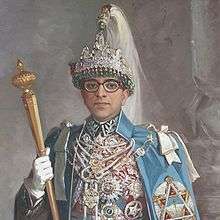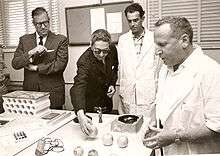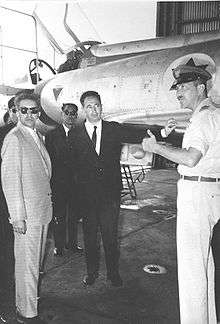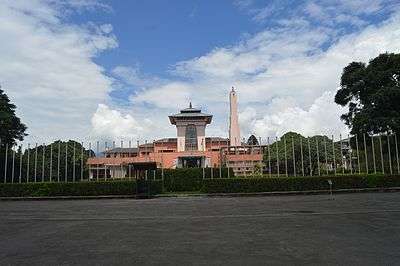Mahendra of Nepal
| Mahendra Bir Bikram Shah | |
|---|---|
 | |
| King of Nepal | |
| Reign | 13 March 1955 – 31 January 1972 |
| Coronation | 2 May 1956[1] |
| Predecessor | Tribhuvan |
| Successor | Birendra |
| Born |
11 June 1920 Narayanhity Royal Palace,[1]Kathmandu, Nepal |
| Died |
31 January 1972 (aged 51) Dialo Bangala, Bharatpur, Nepal |
| Spouse |
Crown Princess Indra Rajya Laxmi Devi (m. 1940–1950, her death) Queen Ratna Rajya Laxmi Devi (m. 1952–1972, his death) |
| Issue |
Princess Shanti Princess Sharada King Birendra King Gyanendra Princess Shobha Prince Dhirendra [2] [3] |
| Dynasty | Shah dynasty |
| Father | Tribhuvan of Nepal |
| Mother | Kanti Rajya Laxmi Devi |
| Religion | Hindu |
Mahendra Bir Bikram Shah Dev (Nepali: महेन्द्र वीर विक्रम शाह) (11 June 1920 – 31 January 1972) was King of Nepal from 1955 to 1972.[4]
Early life
Mahendra was born 11 June 1920 to King Tribhuvan Bir Bikram Shah of Nepal. Although Tribhuvan was nominally king since 1911. Mahendra was captive in Narayanhity Royal Palace, virtually a gilded cage. In 1940 he married Indra Rajya Laxmi Devi,[5] [6] daughter of General Hari Shamsher Rana. They had three sons, Birendra, Gyanendra, Dhirendra and three daughters Shanti, Sharada, and Shobha.[7] Crown Princess Indra died in 1950. In 1952, Mahendra married Indra's younger sister, Ratna Rajya Laxmi Devi. This marriage produced no children. Meanwhile, popular discontent and the British withdrawal from India in 1947 had made Rana rule increasingly untenable. In 1950 the political situation had deteriorated so far that the personal safety of the royals was in doubt. Tribhuvan and most of his family escaped to India. Open revolt ensued and by the end of the year the Ranas agreed to a coalition government under Tribhuvan in which they shared power equally with the Nepali Congress Party. By the end of the year the Ranas were maneuvered out and Nepal's first experiment with democratic government under constitutional monarchy was underway. Tribhuvan's health was poor and he died in 1955.[8]
Reign

Mahendra succeeded Tribhuvan as King of Nepal. He was crowned on 2 May 1956.[9] [10]
1960 Coup d'état
On 15 December 1960, the then King Mahendra suspended the constitution, dissolved the elected parliament, [11] dismissed the cabinet,[12] imposed direct rule and imprisoned the then prime minister Bishweshwar Prasad Koirala and his closest government colleagues.[13][14] Mahendra instituted a Panchayat hierarchical system of village, district and national councils, [15] a variant of guided democracy. He pursued a foreign policy of neutrality between China and India.
Rule in Panchayat System (1960-1972)
In 1960, King Mahendra used his emergency powers and took charge of the State once again claiming that the Congress government had fostered corruption, promoted party above national interest, failed to maintain law and order and ‘encouraged anti-national elements’. Political parties were outlawed and all prominent political figures, including the Prime Minister were put behind bars. Civil liberties were curtailed and press freedom muzzled. King Mahendra, then, through an ‘exercise of the sovereign power and prerogatives inherent in us’ promulgated a new constitution on December, 1962 introducing a party-less Panchayat system. The political system (Panchayat System) was a party-less "guided" democracy in which the people could elect their representatives, while real power remained in the hands of the monarch.[16] Dissenters were called anti-national elements.[17]
The Panchayat System was formulated by King Mahendra after overthrowing the first democratically elected government and dissolving the parliament in 1960. On 26 December 1961, King Mahendra appointed a council of 5 ministers to help run the administration. Several weeks later, political parties were declared illegal. At first, the Nepali Congress leadership propounded a non-violent struggle against the new order and formed alliances with several political parties, including the Gorkha Parishad and the United Democratic Party. Early in 1961, however, the king had set up a committee of 4 officials from the Central Secretariat to recommend changes in the constitution that would abolish political parties and substitute a "National Guidance" system based on local panchayat led directly by the king.[18]
Mahendra implemented a land reform policy, which provided land to many landless people. The Mahendra Highway (also called East-West Highway) that runs along the entire Terai belt in southern Nepal was constructed during his reign. He launched the Back to the Village National Campaign in 1967 which was one of his largest rural development efforts. He also played a key role in making Nepal a member of the United Nations in 1955.
British Field Marshal
King Mahendra was appointed as a British Field Marshal in 1960.
King Mahendra and Queen's visit to USA in 1967
King Mahendra and the Queen Ratna were greeted by the then President of USA, Lyndon B Johnson and Mrs. Johnson in Washington DC in 1967. The royal couple of Nepal was greeted with the 'guard of honor'.[19]
Death and survivors
Mahendra suffered a heart attack while hunting in Chitwan with Tiger Tops Hotel proprietor John Coapman, also associated with the CIA at the time,[20] who reported in 1977 that Mahendra died in his arms after eating dinner "on shikar" and died 31 January 1972 in Bharatpur.[21]
His son Birendra assumed the throne on 24 February 1975 but perished in the Nepalese royal massacre on 1 June 2001.
Titles and honours
- National orders
- Sovereign of the Order of Nepal Pratap Bhaskara
- Sovereign of the Order of Ojaswi Rajanya
- Sovereign of the Order of Nepal Taradisha
- Sovereign of the Order of Tri Shakti Patta
- Sovereign of the Order of Gorkha Dakshina Bahu
- Most Glorious Mahendra Chain (26 February 1961)[1][22]
- Commemorative Silver Jubilee Medal of King Tribhuvan (11 December 1936)[1][23]
- Foreign Honours
-
 Denmark: Knight of the Order of the Elephant, 1960
Denmark: Knight of the Order of the Elephant, 1960 -
.svg.png) Iran: Grand Collar of the Order of Pahlavi, 3 July 1960
Iran: Grand Collar of the Order of Pahlavi, 3 July 1960 -
.svg.png) Iran: Commemorative Medal of the 2500th Anniversary of the founding of the Persian Empire, 14 October 1971.[24]
Iran: Commemorative Medal of the 2500th Anniversary of the founding of the Persian Empire, 14 October 1971.[24] -
 Japan: Collar of the Order of the Chrysanthemum, 19 April 1960
Japan: Collar of the Order of the Chrysanthemum, 19 April 1960 -
 France: Grand Cross of the Order of Legion of Honour, 24 February 1956
France: Grand Cross of the Order of Legion of Honour, 24 February 1956 -
 Finland: Grand Cross with Collar of the Order of the White Rose, 1958
Finland: Grand Cross with Collar of the Order of the White Rose, 1958 -
.svg.png) Belgium: Grand Cross of the Order of Leopold II, 1964
Belgium: Grand Cross of the Order of Leopold II, 1964 -
 Germany: Grand Cross Special Class of the Order of Merit of the Federal Republic of Germany, 1964
Germany: Grand Cross Special Class of the Order of Merit of the Federal Republic of Germany, 1964 -
.svg.png) Kingdom of Laos: Collar of the Order of the Million Elephants and the White Parasol, 1970
Kingdom of Laos: Collar of the Order of the Million Elephants and the White Parasol, 1970 -
 Pakistan: Nishan-e-Pakistan, 1970
Pakistan: Nishan-e-Pakistan, 1970 -
 Netherlands Grand Cross of the Order of the Netherlands Lion, 25 April 1967.[25]
Netherlands Grand Cross of the Order of the Netherlands Lion, 25 April 1967.[25] -
 United Kingdom: Royal Victorian Chain, 26 February 1961
United Kingdom: Royal Victorian Chain, 26 February 1961 -
 Philippines: Collar of the Order of Sikatuna, Rank of Raja, 1971.
Philippines: Collar of the Order of Sikatuna, Rank of Raja, 1971.
Images
.jpg)
 King Mahendra (first from left) visiting Israel accompanied by DG of Ministry of Defense Shimon Peres (center) and Air Force Commander Maj. Gen. Ezer Weizman, 1958
King Mahendra (first from left) visiting Israel accompanied by DG of Ministry of Defense Shimon Peres (center) and Air Force Commander Maj. Gen. Ezer Weizman, 1958 Narayanhiti Palace built by king Mahendra in 1961 under the design of Californian architect Benjamin Polk
Narayanhiti Palace built by king Mahendra in 1961 under the design of Californian architect Benjamin Polk
| Preceded by Tribhuvan Bir Bikram Shah |
Crown Prince of Nepal 1920–1950 |
Succeeded by Gyanendra Bir Bikram Shah |
| Preceded by Gyanendra Bir Bikram Shah |
Crown Prince of Nepal 1951–1955 |
Succeeded by Birendra Bir Bikram Shah |
| Preceded by Tribhuvan Bir Bikram Shah |
King of Nepal 1955–1972 |
Notes
- ^1 Possibly no heir for the time period of 1911 through 1920. Previous Crown Prince: Tribhuvan Bir Bikram Shah, from 1906 to 1911.
References
- 1 2 3 4 "Nepal11". Retrieved 20 July 2016.
- ↑ "King Mahendra of Nepal".
- ↑ "Late King Mahendra with his family".
- ↑ "1954 50p 1rs king mahendra".
- ↑ "King Mahendra Facts".
- ↑ "King Birendra of Nepal". London: Daily Telegraph. 23 August 2001. Retrieved 21 July 2008.
- ↑ "Three princesses". Nepali Times. Retrieved 20 July 2016.
- ↑ Mahendra King of Nepal. Encyclopedia Britannica.
- ↑ "Selected Originals Nepal - Coronation Of…".
- ↑ Pathé, British. "Nepal - Coronation Of King Mahendra". Retrieved 20 July 2016.
- ↑ "Good or bad, right or wrong, for better or for worse, King Mahendra bequeathed a legacy that has shaped the course of political events in Nepal for four long decades.".
- ↑ "The monarchy in full control:1961-1979".
- ↑ "Bisheshwor Prasad Koirala". Spinybabbler.org. 8 September 1914. Retrieved 26 August 2011.
- ↑ "Permanent rebellion: The story of B.P. Koirala". Hinduonnet.com. Retrieved 26 August 2011.
- ↑ "Down came the king...Etihas ko ek kal khanda...Navaraj Subedi".
- ↑ "The Panchayat System under King Mahendra". Library of Congress Country Studies. Retrieved 4 September 2013.
- ↑ "The Koirala Complex". Republica. Retrieved 31 October 2013.
- ↑ "conflict Tuesday, June 7, 2011".
- ↑ "Late King Mahendra and Queen's visit to USA in 1967".
- ↑ ".". An Interesting Institution of Learning. Retrieved 26 August 2011.
- ↑ ".". The New York Times. Archived from the original on 5 March 2010. Retrieved 26 August 2011.
- ↑ "orders". Retrieved 20 July 2016.
- ↑ "ODM of Nepal: King Tribhuvan Silver Jubilee Medal 1935". Retrieved 20 July 2016.
- ↑ "Grand State Banquet". Retrieved 20 July 2016.
- ↑ Benelux Royal